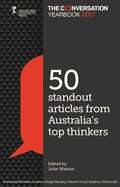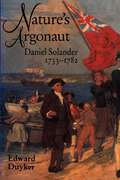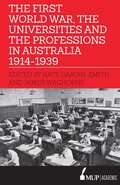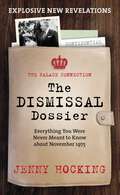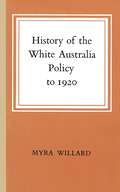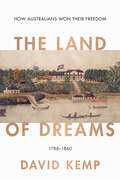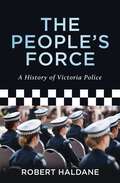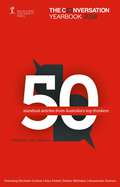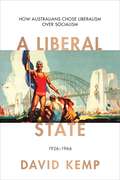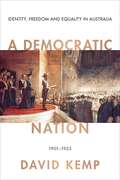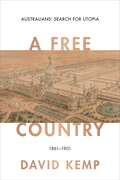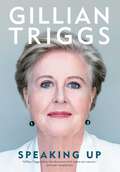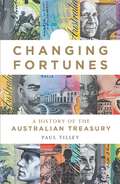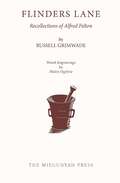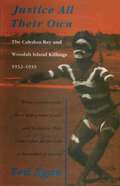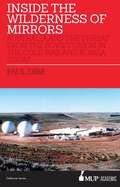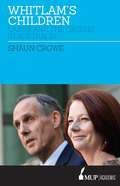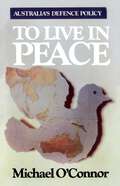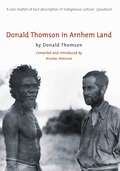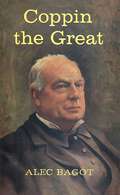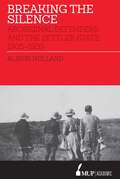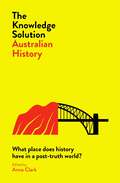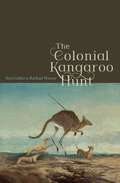- Table View
- List View
Conversation Yearbook 2017: 50 articles that informed public debate
by John WatsonIn a time of heightened hostility towards experts, academics and scientists, the 2017 collection of the best Conversation articles and essays is a must-read. Articles range from a FactCheck of the claim that Indigenous Australians are the most incarcerated people on earth, to answering questions posed by curious children, to Hugh Mackay's observation that the state of the nation starts in your street. Joseph Paul Forgas writes on the surprising benefits of sadness and Stephen FitzGerald considers managing Australian foreign policy in a Chinese world. If proof were needed that academia makes an essential contribution to public debate, you'll find it in these pages. Contributors include: Michelle Grattan, Hugh Mackay, Stephen FitzGerald, Denis Muller, Joseph Paul Forgas, Thalia Anthony, Alan Collins, Rachel Ong and Eileen Baldry.
Nature's Argonaut: Daniel Solander 1733-1782
by Edward DuykerNature's Argonaut is the first full biography of this important eighteenth-century naturalist who not only circled the globe under sail but ranged as far north as the Arctic and as far south as Tierra del Fuego. Edward Duyker pays particular attention to Solander's role as a naturalist on the Endeavour during the ship's voyage along the east coast of Australia and to his pioneering contribution to the scientific study of the new continent. The author has also provided a comprehensive account of Solander's life and his contribution to the foundations of modern plant and animal taxonomy. The life of Daniel Solander, stamped with the enquiring spirit of the Enlightenment, is one of the grand adventures of the eighteenth century. Aside from the historic Endeavour voyage, Solander's Arctic travels, his involvement in industrial espionage in England on behalf of Sweden, his thwarted love for the daughter of his mentor Linnaeus and his friendships with such men as Joseph Banks, James Cook, Samuel Johnson, Matthew Boulton and Benjamin Franklin make Solander an exciting biographical subject.
First World War, the Universities and the Professions in Australia 1914-1939
by Kate Darian-Smith James WaghorneAustralia's extraordinary contribution to World War I extended well beyond its military forces to the expertise of its universities and professional men and women. Scientists and engineers oversaw the manufacture of munitions and the development of chemical weapons. Doctors sustained soldiers in the trenches, and treated the physically and psychologically damaged. Public servants, lawyers and translators were employed in the war bureaucracy, while artists and writers found new modes to convey the trauma of war. The graduates and staff of Australia's six universities—Sydney, Melbourne, Adelaide, Tasmania, Queensland and Western Australia and Queensland—were involved in this expansion of expertise. But what did these men and women do after the guns were silenced? How were the professions and universities transformed by the immediate and longer-term impacts of the war? The First World War, the Universities and the Professions examines how the technical and conceptual advances that occurred during World War I transformed Australian society. It traces the evolving role of universities and their graduates in the 1920s and 1930s, the increasing government validation of research, the expansion of the public service, and the rise of modern professional associations and international networks. While the war contributed to greater specialisations in traditional professions such as teaching or medicine, it also stimulated new jobs and training—whether in economics, anthropology or graphic art. This volume provides a new account of the interwar years that places knowledge and expertise at the heart of the Australian story. Its four sections—The Medical Sciences; Science and Technology; Humanities, Social Sciences and Teaching; and The Arts: Design, Music and Writing—highlight how World War I disrupted and shaped the careers of individuals as well as the development of Australian society and institutions.
Dismissal Dossier: The Palace Connection: Everything You Were Never Meant to Know about November 1975
by Jenny HockingHere is the definitive story of the most divisive episode in Australia's history—the dismissal of Gough Whitlam's Labor government. In her award-winning biography of Gough Whitlam, Jenny Hocking revealed the astonishing secret story of the planning and the people behind the dismissal. Never before released material from Sir John Kerr's private papers revealed the secret role of High Court justice Sir Anthony Mason and Kerr's collusion with Malcolm Fraser. Now, Hocking's forensic investigations reveal explosive files in the UK National Archives that add a disturbing dimension to this untold story. Hocking reveals the Palace connection and unravels the web of intrigue behind the British Office's link to the dismissal of the Whitlam government in the name of the Queen. She brilliantly brings together this hidden history—a mixture of the unknown, the overlooked and the clandestine—to write a political thriller: the story you were never meant to know.
Hinch vs Canberra: Behind the human headline
by Derryn HinchAs a current affairs commentator, Derryn Hinch spent decades fighting with politicians. Then the unthinkable happened he became one. This is the inside story of Senator Hinch's first year in Canberra. Explosive, incisive, frank, brutal, and, at times, very funny.
History of the White Australia Policy to 1920
by Myra WillardThis remarkable work was the first to examine the White Australia policy, and was the first book published by Melbourne University Press, in 1923. It has long been the authoritative reference on the subject, and is essential for every library. Though more than ninety years have passed since publication, the book remains invaluable. It surveys restrictions on immigration by the States before Federation, the system of indentured labour, and gives a picture of a young community protecting itself from immigration which would have altered its whole character.
Land of Dreams: How Australians Won Their Freedom, 1788-1860
by David KempThe Land of Dreams: How Australians Won Their Freedom, 1788-1860 tells the story of how Australians became a free people, gaining the liberties they desired to take control of their own lives, the right to govern themselves and the capacity to address their own political problems through democratic institutions. As the first book in a path-breaking five-volume Australian Liberalism series, it tells the story of how Australians laid the foundations for one of the world's most successful countries, with unprecedented levels of personal liberty and social equality. Australians did not have to fight a war for their independence, but neither did they gain it without a struggle against policies imposed by a British government in which they had no part. It required a brilliant political campaign that walked to the edge of violent resistance and from it Australia gained a national identity and political leaders who would write their constitutions, introduce democracy and later lead the successful political fight for one Australian nation.
People's Force
by Robert HaldaneSince its formation in 1853 the story of the Victoria Police has been interwoven with Victorian social and political history. Following the amalgamation of seven separate and distinct police agencies in the colony, the resultant unified body was the first of its kind in Australia. Many events have shaped its development: the gold rushes, the Clunes riot, the Kelly outbreak, the maritime strikes, the coming of the motor car, the police strike, both world wars and the Vietnam war protests, the gangland wars, Black Saturday bushfires and the use of DNA to solve crimes all formed part of this mosaic. This revised edition of The People's Force, containing a new chapter and new illustrations, brings the history up to date to include a decade that has been full of turbulent change. The new chapter examines the administrations of Neil Comrie, Christine Nixon, Simon Overland, Ken Lay and Graham Ashton. New material deals with Silk and Miller, and other police shootings, the growth of terrorism, gender issues, racism and domestic violence. Written as a 'warts and all' history of the Victoria Police with the support and encouragement of the then Chief Commissioner S. I. ('Mick') Miller, who wanted a proper objective history of the force, not a public relations exercise. This third edition is owed largely to Miller's encouragement and his desire to see the history updated.
Conversation Yearbook 2018: 50 standout articles from Australia's top thinkers
by John WatsonIn an era when everyone has an opinion, we rely on facts more than ever. Australia's leading thinkers give their robust opinion on the arguments and issues that fuelled public debate in 2018. This collection of essays brings you the best of the authoritative journalism for which The Conversation is renowned. Immerse yourself in the insights of experts and navigate the key questions of our times.
Liberal State: How Australians Chose Liberalism over Socialism 1926–1966
by David KempA Liberal State: How Australians Chose Liberalism over Socialism 1926-1966 explores the revival of Australian political liberalism after the Great Depression of the 1930s and its sweeping domestic political triumph after World War II over utopian socialism. The fourth title in a landmark five-volume Australian Liberalism series, A Liberal State examines how Australians reasserted their claim to control their own lives, following decades of expanded government control over economic and social life, and intrusive wartime and post-war restrictions. From the 1920s Robert Menzies became the major voice for liberal thought in the nation's political life and David Kemp looks at his role in reconstructing liberal and conservative politics. The book highlights the importance of the factional struggles within the Labor Party arising from its adoption of a Socialist Objective, and the domestic and international advance of utopian socialist ideology during World War II and the Cold War. A Liberal State tells of Jack Lang's advocacy of the socialisation of industry in New South Wales in the 1930s, and of Menzies as war-time prime minister and his key relationship with John Curtin. It assesses Menzies's historic Forgotten People statement of liberal ideas, the formation of the Liberal Party of Australia, and how, after his election victory in 1949, Menzies rebuilt a liberal basis for national policy during sixteen and a half years as prime minister.
Democratic Nation: Identity, Freedom and Equality in Australia 1901–1925
by David KempA Democratic Nation: Identity, Freedom and Equality in Australia 1901-1925 tells the story of the political battle after Federation to achieve unprecedented levels of social and economic equality, while preserving both national independence and individual freedom. As the third book in a landmark five-volume Australian Liberalism series, A Democratic Nation shows how Australians, inspired by the exceptional democracy they had achieved, set out to perfect its principles while protecting it from a world they saw as increasingly threatening. The period saw political battles within and between Liberal and Labor parties as attempts to protect identities defined by nation, class and race confronted ideas of individual freedom and equality. As the war of 1914-18 between the European empires gave rise to unimaginable horrors, economic chaos and continuing violence, the Australian Labor Party shattered and the Liberal Party became submerged in a new Nationalist win-the-war alliance. In peacetime it struggled to restore the nation's social and economic health under the weight of pre-war and wartime identity-based policies. Throughout years of divisive political conflict, the Australian people would remain largely faithful to their hope of a land that would give them freedom to chart their own destinies, and would resist the siren calls of those who promised a conflict-free world by the use of centralised power to reconstruct the industrial and social order.
Free Country: Australians' Search for Utopia 1861–1901
by David KempA Free Country: Australians' Search for Utopia 1861-1901 tells how Australians, inspired by their new democracy, attempted to use their freedom to build a society without social and economic conflict. As the second book in a landmark five-volume Australian Liberalism series, A Free Country shows the successes and missteps in the attempt to establish the legal and moral foundations for a liberal society in Australia, examining the ideological battles of the period. The national politics of twentieth-century Australia had their roots during this time, as utopian dreams of 'social reconstruction' opposed liberal ideals of individual freedom, fostering the concept of 'class wars' and leading to the ongoing involvement of trade unions in politics. As emerging collective ideas of nationalism, empire, race and class challenged individual rights and threatened to seed domestic and international conflict, liberals succeeded in bringing the six colonies into one Australian nation founded on liberal principles, writing a constitution hailed as the most democratic in the world.
Speaking Up
by Gillian TriggsAs president of the Human Rights Commission, Gillian Triggs advocated for the disempowered, the disenfranchised, the marginalised. She withstood relentless political pressure and media scrutiny as she defended the defenceless for five tumultuous years. How did this aspiring ballet dancer, dignified daughter of a tank commander and eminent law academic respond when appreciative passengers on a full airplane departing Canberra greeted her with a round of applause? Speaking Up shares with readers the values that have guided Triggs' convictions and the causes she has championed. She dares women to be a little vulgar and men to move beyond their comfort zones to achieve equity for all. And she will not rest until Australia has a Bill of Rights. Triggs' passionate memoir is an irresistible call to everyone who yearns for a fairer world.
Changing Fortunes: A History of the Australian Treasury
by Paul TilleyTreasury has been at the centre of every major economic policy issue the Australian Government has faced, its role evolving from the government's bookkeeper at Federation in 1901 to the economic policy advising agency it is today. Throughout its history Treasury has been a robust and stable institution with a consistent market-oriented economic framework - but its policy influence has waxed and waned. It has supported reformist Treasurers such as Keating and Costello, and been a voice of caution when political imperatives have pushed governments down economically damaging paths. At times, though, Treasury advice has been ignored and it has been pushed out into the cold. Amidst the political chaos of recent times, Treasury has been dragged closer to government and become a less effective policy adviser. The consequent lack of a consistent government economic reform narrative over the last decade is plain for all to see. Changing Fortunes tracks Treasury's history since Federation, with a focus on the modern era since its 1976 split with Finance.
Flinders Lane: Recollections of Alfred Felton
by Russell GrimwadeAlfred Felton started his fortune during the Australian gold rushes, selling 'Felton's Quinine Champagne' to miners. Later, he partnered with Frederick Grimwade to found a successful pharmaceutical company, Felton Grimwade & Co., and built 'the handsomest drug house in Australia', a bluestone warehouse in Flinders Lane. Their empire moved into glass manufacture, and by the time of his death, Felton was a rich man. He bequeathed most of his wealth to the National Gallery of Victoria; the value of the works acquired has now reached more than $2 billion. Flinders Lane: Recollections of Alfred Felton tells the story of this extraordinary benefactor. Illustrated with wood engravings by Helen Ogilvie, this new edition has a foreword by Sir Andrew Grimwade, great nephew of the author.
Justice All Their Own: The Caledon Bay and Woodah Island Killings, 1932–1933
by Ted EganAs punishment for murder, Aboriginal justice often calls for a ceremonial spear-thrust through the thigh. In Arnhem Land in the Northern Territory of Australia, the ceremony is called Makarrta. The white justice system demands imprisonment for life. Which justice should prevail? What is fair? Which is right? Ted Egan, well-known bushman, folklorist and media personality, is uniquely place to write this book. His close association with Aboriginal people enabled him to interview participants in the events—he 'sat down' in the country where the incidents took place. The product of forty years' research, this account of the killings, the protests and the subsequent trials in Darwin in 1934 presents a thorough analysis of the motives and behaviour of the various participants. It shows the disturbing and distressing consequences of the imposition of the British system of justice on people accustomed to their own predictable, consistent legal system, which itself is the product of a complex culture developed over thousands of years.
Inside the Wilderness of Mirrors: Australia and the threat from the Soviet Union in the Cold War and Russia today
by Paul DibbThroughout the Cold War Paul Dibb worked with the highest levels of Australian and American intelligence, and was one of very few Australian officials to be given the top-secret security clearance for access to Pine Gap. Only the most senior intelligence officers in both the US and Australia held this clearance—and even then on a strict 'need to know' basis. Inside the Wilderness of Mirrors is Paul's unique insight into how Australia saw the threat from the Soviet Union during the Cold War era and beyond. This insider's account of Australian defence strategy reveals the crucial importance of the US-Australian base at Pine Gap and why Moscow targeted it for nuclear attack, and how it felt to be an expert on the Soviet Union at a time when those who dared to study the Soviet Union were necessarily subject to suspicion from their Australian colleagues. Inside the Wilderness of Mirrors concludes by examining the ways in which contemporary Russia presents a continuing threat to the international order.
Whitlam's Children: Labor and the Greens in Australia
by Shaun CroweOver the past three decades, progressive politics in Australia has undergone a gradual but unmistakable transformation. Where the Australian Labor Party once enjoyed dominance over the political left it now shares space with the Greens; at times depending on minor-party support to form government, and even more often to pass contentious legislation. Based on over forty interviews with politicians and party figures, Whitlam's Children is the first study of this increasingly important relationship in Australian politics. Did previous attempts at cooperation, particularly minority government under Julia Gillard, deliver successful government, and how do each judge the experiment in hindsight? Why are certain policy areas, like refugee settlement and environmental policy, so stubborn and divisive? And will we ever see a more lasting coalition on the Australian left, to mirror the established arrangement on the Australian right? While revealing a variety of perspectives, even within parties, the research uncovers a productive, if often hostile relationship; united by a series of shared values, but divided by different approaches to politics, elections and parliament. Featuring a preface by Geoff Gallop
To Live in Peace: Australia's Defence Policy
by Michael O'ConnorIn the eyes of most people defence does not become a problem until the bombs begin to fall. Michael O'Connor argues persuasively that it is high time that governments and concerned individuals did something to counter the 'benign neglect' of defence policy which is the norm in Australia. National security, like any other product of government, must be marketed as well as managed. Australia as a community suffers badly from the refusal of governments and their advisers to take the citizenry into their confidence. Occupying the high ground in public debate, the Defence Department uses weapons of secrecy and assertions of special knowledge as well as more disreputable debating tactics to stifle criticism. In general, this overall political neglect of national security questions in the climate of 'no-threat' assertions has led to the creation of a Defence Force which lacks some of the most elementary logistic support and political control mechanisms. Politically, defence is regarded as a problem that will be dealt with when the need is urgent-when it will be too late and exceedingly costly in lives and money. No one who reads this book can fail to be frightened—not by the threat of nuclear war or holocaust—but by the total inability and inadequacy of our defence forces to meet such a nightmare now. Our national conservatism threatens our security more than it ever did in the days of total war.
JB Chifley: An Ardent Internationalist
by Julie SuaresThis, combined with his rural background and commitment to the labour movement, played a major role in the development of his internationalist perspective. Often overlooked by historians, Chifley believed that the only way to avoid war and economic depression was through the establishment of international rules-based economic and collective security institutions. These were beliefs he had held since the early 1930s. Chifley was a prime minister with a keen interest in post-war Asia, who understood that the old colonial order was ending. He was a great admirer of the Indian Prime Minister, Jawaharlal Nehru. This book reveals the extraordinary convergence of worldviews of two fellow internationalists, Chifley and Nehru. This convergence can be seen in their views on the need to adjust to a changing post-colonial world; their internationalism; their support for the United Nations; their opposition to Western colonialism; their anti-war attitudes and their animosity towards the American and British Cold War framework through which the post-war world was viewed. Historian Frank Bongiorno wrote about Julie's work on Chifley: ' . . . it is a tremendous achievement to produce such a new vision of a major political figure . . . it is an important contribution to Australian political, foreign policy and intellectual history'.
Donald Thomson In Arnhem Land
by Nicolas Peterson'I had lived and hunted with these people, accompanied them on their nomadic wanderings and learned their customs and their languages with the result that I understood and believed in them and resented the injustices under which they had suffered for so long at the hands of the white man and other invaders of their territory.' In 1932-33, Yolngu people living in the Caledon Bay area of north-east Arnhem Land were involved in the killing of five Japanese fishermen and three Europeans. A punitive expedition was proposed to 'teach the Aborigines a lesson'. In response, Donald Thomson, a Melbourne-born anthropologist, offered to investigate the causes of the conflict. After seven months of investigation he persuaded the Federal Government to free the three men convicted of the killings and returned with them to their own country, subsequently spending fifteen months documenting the culture of the region. Whilst in Arnhem Land, Thomson, a superb and enthusiastic photographer, made the most comprehensive photographic record of any fully functioning, self-supporting Aboriginal society that we will ever have. The one hundred and thirty images included in this book cover domestic life, subsistence, house types, material culture, and religious life, providing a uniquely privileged glimpse of life beyond the frontier. Thomson recorded his experiences in newspaper and academic articles, private papers and extended reports to the government. Nicolas Peterson brings this material together as a compelling, highly personal narrative in Thomson's own words. It is a narrative that names all the Aboriginal people involved, presenting them as individuals in a way no other writings of the time do. Through it all Thomson's passionate commitment to Aboriginal rights as defender, critic and advocate, shines through.
Coppin the Great: Father of the Australian Theatre
by Alec BagotGeorge Seith Coppin (1819-1906), known as 'father of the Australian Theatre', a 'low comedian', was also impresario, adventurer, politician and philanthropist. This biography is based mainly on material made available by the late Miss Lucy Coppin: her father's books, journals, biographical notes, press cut-tings, playbills, and Coppin's personal letters. From an early age he acted with his parents in a troupe of strolling players in England and the colour-and uncertainties-of this life are vividly described. At 16 he chose in-dependence and appearances in provincial England, London, and Ireland followed. In 1842, accompanied by an American actress, he migrated to Australia where, in tours of the separate colonies, George's acumen gave them starring roles and excellent receipts. As well as acting and managing, Coppin pro-moted such ventures as a zoo, roller skating, hot sea-water baths and a railway line. He was a devoted husband and parent and his philanthropic activities were legion. Twice elected to the Victorian Legislative Council, in 1858 and 1889, Coppin was also a member of the Legislative Assembly for nine years 1874 to 1889, with a break 1877-1883. He built six theatres, including one pre-fabricated in England. He made three for-tunes and lost two, restoring them through stage tours. He toured the Victorian gold-fields and New Zealand and, later, with Charles and Ellen Kean, America. This visit coincided with a presidential election and the assassination of President Lincoln.
Breaking the Silence: Aboriginal Defenders and the Settler State, 1905–1939
by Alison HollandBreaking the Silence recovers the conflicted politics of Aboriginal affairs in the first decades of the twentieth century. From 1905, when the report of the controversial Roth Royal Commission in Western Australia was made known to the public, to the eve of World War II, the condition, status and treatment of Aboriginal Australians were leading social questions that generated much discontent and underscored the awakening of a national conscience. Styled the 'new public', defenders lobbied governments to develop policies to ensure viable Aboriginal futures. In charting aspects of this politics, Alison Holland uncovers the defenders' programs for reform and the responses of governments to them. She shows how the consternation of the defenders was disproportionate to political will. Governments didn't listen or hear. They viewed the issues and solutions in different ways. Where defenders saw a humanitarian crisis, governments identified a colour problem in White Australia and developed policies to eradicate it. Breaking the Silence shows that there was no 'great Australian silence' on this question in the first half of the twentieth century. While the history books may have been silent, the politics on the ground, in the press, the auditorium, parliament, university, church and mission were anything but. Holland asks why this was so. What form did this politics take, what was at stake and what were the outcomes? In answering these questions the book provides important historical context for the consternation and debates still being had in the Australian polity over Aboriginal affairs.
Knowledge Solution: What place does history have in a post-truth world?
by Anna ClarkWhat can we learn from recurring events across the recent history of Australia, of colonisation, nationalism, racism, fighting on foreign shores, land booms, industrial campaigns and culture wars? Arguments about the discipline of Australian History, from thinkers across the ideological and historical spectrum, are distilled in these extracts and essays. The Knowledge Solution: Australian History is the second collection in a series that draws from the remarkable books published by Australia's oldest university press. Contributors include: Bain Attwood, Geoffrey Blainey, Michael Cannon, Raffaello Carboni, Manning Clark, Peter Cochrane, James Curran, Mark Davis, Alexandra Dellios, Richard Evans, Michele Grossman, Marcia Langton, Helen MacDonald, Stuart Macintyre, Janet McCalman, Mark McKenna, Lisa Palmer, Ray Parkin, Rachel Perkins, Robert Reynolds, John Rickard, Kathryn Shain, Peter Spearritt, Peter Sutton, Rebe Taylor, Maureen Tehan, David Unaipon, Jo Wainer, Stuart Ward, Ellen Warne, Myra Willard and Alexis Wright.
Colonial Kangaroo Hunt
by Ken Gelder Rachael WeaverFrom the arrival of Captain James Cook in 1770 to classic children's tale Dot and the Kangaroo, Ken Gelder and Rachael Weaver examine hunting narratives in novels, visual art and memoirs to discover how the kangaroo became a favourite quarry, a relished food source, an object of scientific fascination, and a source of violent conflict between settlers and Aboriginal people. The kangaroo hunt worked as a rite of passage and an expression of settler domination over native species and land. But it also enabled settlers to begin to comprehend the complexity of bush ecology, raising early concerns about species extinction and the need for conservation and the preservation of habitat.
